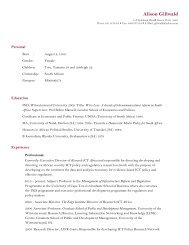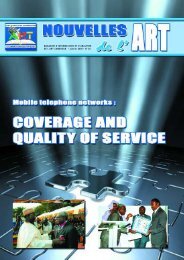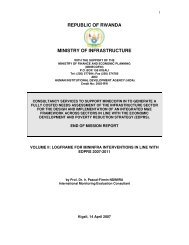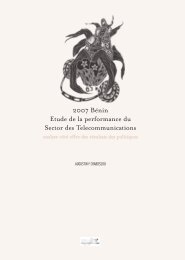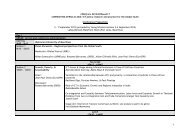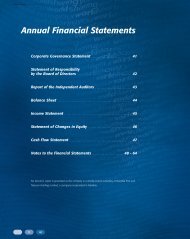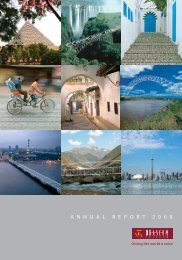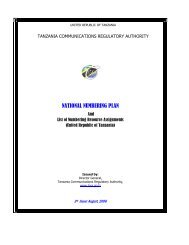Zambia ICT Sector Performance Review 2010 - Research ICT Africa
Zambia ICT Sector Performance Review 2010 - Research ICT Africa
Zambia ICT Sector Performance Review 2010 - Research ICT Africa
Create successful ePaper yourself
Turn your PDF publications into a flip-book with our unique Google optimized e-Paper software.
<strong>Zambia</strong> <strong>ICT</strong> <strong>Sector</strong> <strong>Performance</strong> <strong>Review</strong> 2009/<strong>2010</strong><br />
• protect the interest of consumers; and<br />
• promote research and development in <strong>ICT</strong>s<br />
In addition to the above, the <strong>ICT</strong> Act also provides a new framework for resolving disputes in the<br />
sector. This is an important improvement given the past history of litigations and numerous<br />
unresolved disputes in the sector.<br />
Broadcasting<br />
Broadcasting in <strong>Zambia</strong> dates back to 1941 11 , when the colonial government opened a radio<br />
station in Lusaka. For nearly half a century, radio and television broadcasting was a preserve of the<br />
state. The early 1990's saw the re-emergence of plural politics in the country and subsequently the<br />
liberalisation of the media industry. The result has been a proliferation of private-owned<br />
newspapers, private radio stations and community radio stations 12 . The Ministry of Information and<br />
Broadcasting Service (MIBS) is responsible for policy and oversight over the regulator. However, in<br />
view of the non-existence of the regulator, MIBS exercises both policy and regulatory functions in<br />
the sector.<br />
The key legislation that governs the regulatory framework for the broadcasting sector in <strong>Zambia</strong><br />
consists of the following:<br />
• <strong>Zambia</strong> National Broadcasting Corporation (ZNBC) Act of 1987<br />
• <strong>Zambia</strong> National Broadcasting (ZNBC) (Licensing) Regulations (1993)<br />
In 2003, the Government provided further stimulus for the liberalisation of the broadcasting<br />
industry through the enactment of the following laws:<br />
• Independent Broadcasting Authority Act No 17 of 2002<br />
• ZNBC Amendment Act of 2002<br />
In 2007, the Government enacted the Independent Broadcasting Authority (IBA) Act that provides<br />
for the establishment of the Independent Broadcasting Authority (IBA) to regulate the broadcasting<br />
sub-sector. However, the establishment of the IBA has been mired in a legal controversy 13 and the<br />
regulatory agency has not yet been established as of mid- <strong>2010</strong>.<br />
Licensing Regime<br />
The <strong>ICT</strong> policy and the new 2009 legislation recognises the trends towards convergence and<br />
provides for a corresponding technology-neutral licensing framework with two main categories of<br />
authorisations, namely:<br />
• a network licence which authorises its holder to construct, own or make available an<br />
electronic communications network, or to provide a network service; and<br />
• a service licence which permits its holder to provide one or more electronic<br />
communications services.<br />
In the <strong>ICT</strong> Act, an “electronic communications network" is defined as a transmission system that<br />
permits the conveyance of information irrespective of the technology used or the type of<br />
information conveyed. An "electronic communications service" is defined to mean, “A service<br />
provided by means of one or more electronic communications networks.”<br />
The above new licences are further classified into two categories, namely; individual and class<br />
licenses.<br />
The establishment of<br />
the Independent<br />
Broadcasting<br />
Authority has been<br />
mired in a legal<br />
controversy and the<br />
regulatory agency has<br />
not yet been<br />
established as of mid-<br />
<strong>2010</strong>.<br />
License Categories<br />
i. Individual Licenses<br />
Individual licenses are major network or service licences with significant economic and social<br />
impact as well as regulatory obligations. These licenses, which may also require the use of radio<br />
frequency spectrum and other scare resources such as numbering, shall be issued through<br />
11 See (Mulozi, 2008)<br />
12 See (Shuller2004)<br />
13 (MISAMEdiareport)<br />
5



